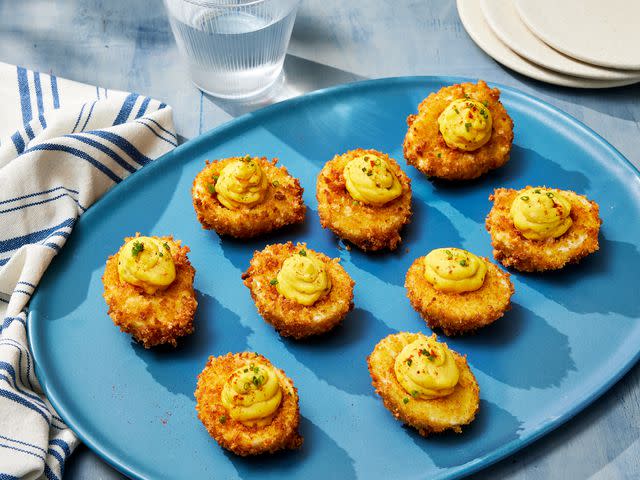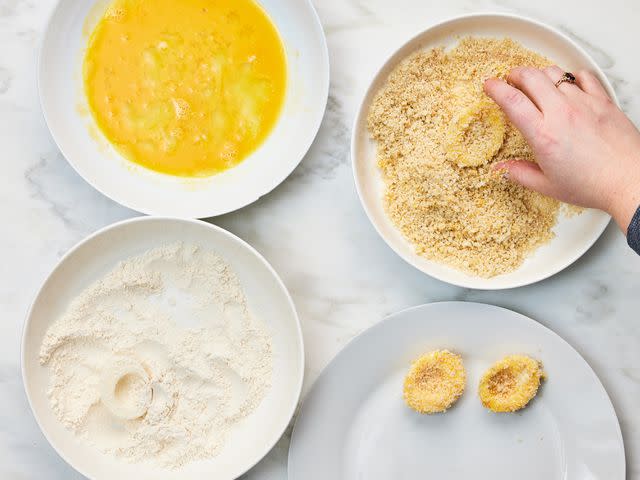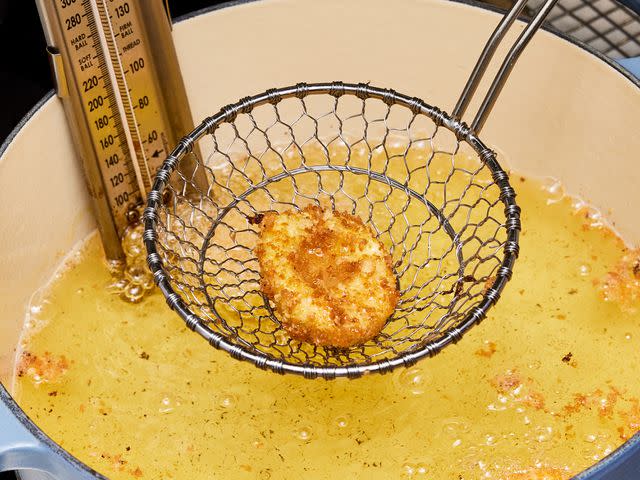Deviled Eggs Just Got the Upgrade We’ve All Been Waiting For
One extra step is all it takes to make the best you've ever had.
Deviled eggs are always a favorite. Name a more classic dish to pass around—we'll wait. On their own, they are pretty perfect, but that perfection also allows for countless variations that appeal to any palate. You really can't go wrong with a deviled egg. We've seen spicy spins, crab-stuffed treats, bacon-studded bites, and fun twists in between. But the upgrade we've all been waiting for is finally here with our Deep-Fried Deviled Eggs recipe that yields crispy, crunchy, yet delightfully creamy results.
With one extra step, you can take everyday deviled eggs up a notch for a snack that will get everyone talking. So set up your breading station and get ready for a game-changing upgrade.

Dotdash Meredith Food Studios
The 1-Step Upgrade for the Best Deviled Eggs
In case it's not yet clear, the twist we're taking here is coating and frying the egg white halves of otherwise-traditional deviled eggs for an appetizer glow-up to serve at your next soirée.
Recipe developer Catherine Jessee says it best, "Crispy crunchy on the outside, topped with a tangy and tart, yet creamy yolk filling. This isn’t your typical deviled egg: it’s like a katsu deviled egg—dare I say, 'Tastes like chicken?' But truly, for haters of deviled eggs, this will sway you in the devilish direction. It’s a little richer, a lot crispier, and unforgettable. Hot sauce is a must."
"I’m a huge deviled egg fan, and I never thought they were missing anything until I tried them CRISPY. What a delight!"
Recipe tester Julia Levy
How to Make Deep-Fried Deviled Eggs
These deviled eggs are relatively straightforward but where they really shine is in the crispy coating that adds crunchy texture and added dimension that make the added effort well worth it. Follow these simple instructions.
Deep-Fried Deviled Eggs Ingredients
First things first, gather the ingredients, which are all easy to find at the store or even in your pantry.
Hard-boiled eggs: Cut peeled, cooked eggs in half, and set the yolks aside for the filling.
Filling: Egg yolks, mayonnaise (Duke's, or your favorite), relish, Dijon mustard, and seasonings make up the dreamy dollop to each fried white.
Breading station: Grab flour, more eggs (raw this time), and panko bread crumbs (with added Parmesan and cayenne for flavor).
Deep-fry station: Pull out a large Dutch oven or heavy-bottomed pot and enough canola to fill it with 1 1/2 inches of oil.

Dotdash Meredith Food Studios
How to Prepare Deep-Fried Deviled Eggs
As mentioned above, start with prepared, peeled hard-boiled eggs and cut them in half. Separate the yolks, keeping the whites intact.
Mix together the yolks, mayonnaise, relish, Dijon, salt, and pepper until smooth and combined. Transfer to a piping bag or zip-top plastic bag and set aside to garnish each fried egg white half.
Prepare a breading station, using three separate bowls for the flour, beaten eggs, and seasoned bread crumbs. Dredge each egg white half in flour, then egg, and finally bread crumbs.
Working in batches, fry the coated egg whites in hot oil until golden brown, about 30 seconds to 1 minute, adjusting heat as needed to maintain the cooking temp of 360 degrees F. Transfer to a paper towel-lined plate.
Finally, pipe the egg yolk mixture evenly (about 1 tablespoon each) into the center divot of each fried egg. Garnish with chives and paprika and serve warm topped with a drizzle of hot sauce, if you like.
Recipe Tip
A note from our test kitchen: It’s important to work quickly especially when dredging the egg in panko—the beaten egg might try to slide off the flour layer on the egg white. Working quickly seals everything in and creates the breaded exterior.
What Temperature Do You Deep Fry Eggs?
According to our test kitchen experts, the typical deep frying temp is at least 350 degrees F (175 degrees C). Some recipes call for a higher cooking temperature of 375 degrees F (190 degrees C). For this recipe, 360 degrees F (about 182 degrees C) is a happy medium that accounts for the gain and loss of temperature as the eggs cook.
Get more helpful deep-frying tips to use in this and other recipes here.

Dotdash Meredith Food Studios
Tips, Tricks, and Substitutions for Deep-Fried Deviled Eggs
Follow these suggestions from our team:
Use pre-boiled eggs to cut down on prep time. Unpeeled cooked eggs last up to a week in the fridge in an airtight container. Peeled eggs last in the fridge, in cold water, for two to three days.
To further save time, the egg filling can be prepared the day before and stored in an airtight container in the refrigerator.
Substitute sweet pickle relish for dill pickle relish, or use chopped-up fresh pickles.
Incorporate some chives into the yolk mixture for some extra freshness.
Use whatever filling flavoring you like because, "for once in the deviled egg’s life, the star of the show is the white!" says recipe tester Julia Levy.
How to Store Deep-Fried Deviled Eggs
Because of the crispy exterior, these deviled eggs are best enjoyed right after frying. They should be discarded after two hours if they are left to sit out at room temperature. If you have leftovers, keep them in the fridge but just know the breading will soften and they won't be quite the same.
Read the original article on All Recipes.

